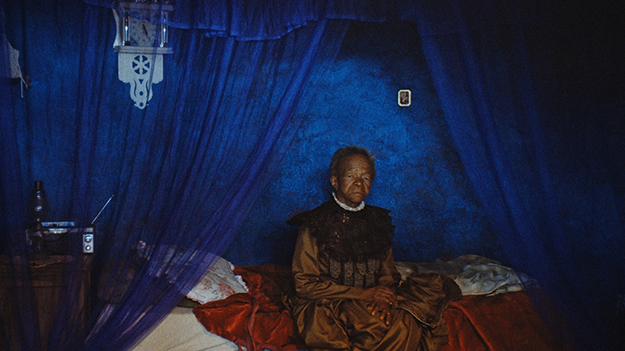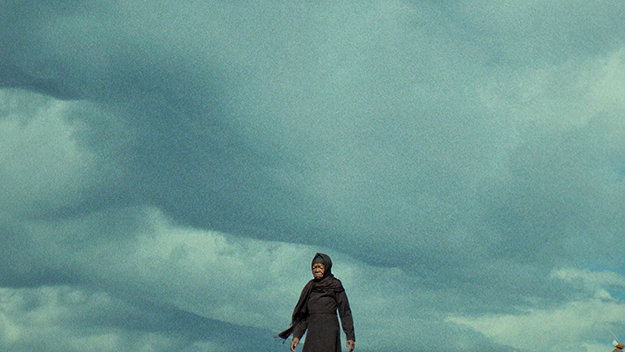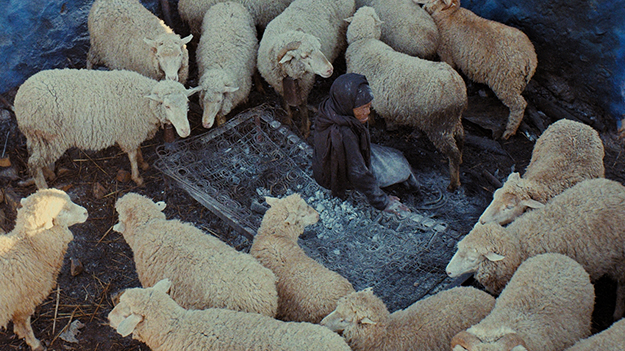Sundance Dispatch: This Is Not a Burial, It’s a Resurrection

Mary Twala Mlongo in This Is Not a Burial, It’s a Resurrection (2019)
Last Saturday, Lemohang Jeremiah Mosese’s third feature, This Is Not a Burial, It’s a Resurrection, won a Special Jury Award for Visionary Filmmaking at the 2020 Sundance Film Festival, where it was screened in the World Dramatic Competition. Like Pedro Costa’s Vitalina Varela, Mosese’s film had seemed like an odd (but welcome) selection for Park City: cryptic and singular in shape, dazzling in its play with light and landscape, and rigorously specific to its setting in the highlands of Lesotho, This Is Not a Burial felt worlds apart from the breezier and more traditional fare that makes up most of the festival’s narrative feature lineup.
The film tells the story of an 80-year-old woman, Mantoa (Mary Twala Mlongo), who discovers on Christmas Day that her son has died in a mining accident in South Africa. With no family left alive, she starts making arrangements for her own burial—only to be told by the city council that her landlocked village, Nasaretha, is about to be flooded for the construction of a dam and that its residents will be resettled in the city. But Mantoa is resolute in her desire to be buried alongside her ancestors, even as her neighbors pack up their belongings and, harrowingly, dig up their dead to take them along.
In a phone interview before the festival, Mosese told me that this Gothic premise has its roots in reality. As part of the “Highlands Water Project” conceived under apartheid, Lesotho exports 780 million cubic metres of drinking water every year to South Africa. This entails the construction of reservoirs that force villagers out of their homes and into urban centres. They leave behind their land, crops, and livestock, and must either exhume their dead or abandon them to the flooding. Mosese recounted shaking hands with Nelson Mandela as a boy when the South African president visited Lesotho to inaugurate a dam, and realizing later the irony of this “lauded knight of democracy,” as he described Mandela, coming to his country to continue the imperialist water project.

“I’ve been wrestling with the whole idea of displacement for a very long time,” said Mosese, who was evicted from his home when he was young, and whose grandmother’s village is now undergoing the same fate depicted in This Is Not a Burial. Mosese’s interest in exile and migration also comes from his current life in Berlin, where he has been based for the last eight years. “I live in Germany as an Other,” he said. “I can create better art from [in-between] these two spaces, but it also makes me a very lost person.” His experimental documentary, Mother, I Am Suffocating. This Is My Last Film About You., explored that feeling of adriftness, combining evocative, black-and-white images of faces, hands, and the crowded streets of Lesotho with a mournful voiceover about viewing one’s (postcolonial) motherland through the eyes of an outsider.
Although This Is Not a Burial is inspired by similar historical and topical realities, the film unfolds like a surrealist fable, with fragmented editing; arch, myth-infused dialogue; and an unearthly soundtrack composed by Japanese noise musician, Yu Miyashita. The film’s oneiric opening sequence takes place late at night in a seedy bar. The camera wanders through smoke-filled chiaroscuro and then settles on an elderly lesiba player and raconteur (Jerry Mofokeng Wa Makhetha) who starts narrating ancient tales of war and plague and drowned cities that situate the film in the realm of legend. When I asked Mosese about the bar scene, his explanation also sounded more dreamed up than written.
“When I’m in the club, and it’s very late in the morning, it’s such a terror to me. When it’s almost empty, but there’s that one person dancing in a weird way, and there’s a fan creaking on the ceiling… and then someone starts talking about places that are no more. I find it very sad and romantic,” he said. “Their minds are not here. They’re somewhere else.”
The rest of the film switches erratically between social drama, mystery, and horror as Mantoa goes around rallying the villagers to join her in resisting the dam. When she confronts the village councilman, the dialogue turns bluntly political: “When they claim progress is when men point their demanding fingers at nature and proclaim conquest over it.” Although the chief eventually comes around—in a surprisingly comical scene in which the villagers gather around a table to write a letter to the king—others rise in opposition to Mantoa, mysteriously setting fire to her beloved blue hut. She tries other means to outrun the coming of the dam: at one point, she dons her finest silk dress and lays in her bed, regally awaiting death; at another, she tries to dig her own grave in the dark of the night, a wiry silhouette against the inky horizon.

Mosese said that his idiosyncratic approach—which prioritizes images and sensations over scripted narrative—comes from the fact that he’s not a trained filmmaker. In fact, This Is Not a Burial is the first narrative feature by a Lesotho director. “Where I grew up, there was nobody who made films,” Mosese said. “So you don’t have a reference of someone who can actually make you dream of making movies.” He studied human resource management in college and later entered the art world through poetry and video work, before foraying into filmmaking. “I create from a place of subconscious,” he said. “I have an idea and I run with it. Because I didn’t go to film school, I never learned to question things. Questions of structure or logic come last [to me].”
And yet there is something pristine about the visuals in This Is Not a Burial. Although the process of making the film in the remote mountainous village of Ha Dinizulu was fraught—there was limited electricity and water, and equipment had to be brought in from South Africa on horseback and mules—the landscape and its vibrant flora make for ethereally vivid tableaux in the film, as do the traditional blankets and shawls of Lesotho (a country whose striking colors and designs inspired some of the costuming in Ryan Coogler’s Black Panther). Surprisingly, for Mosese, the beauty of the location was a cause of concern. “The curse of shooting in Africa, because it is so beautiful, is that you can end up pigeonholing yourself within beauty. I don’t want the conversation to end in beauty,” he said. “That’s why I chose the 4:3 [Academy] ratio, because otherwise the movie would be way too beautiful and that would overshadow the story. So I showed as little as I could.”
The most obvious forebear of This Is Not a Burial might be Djibril Diop Mambéty’s Hyenas, which also centers on an elderly woman and critiques the incursions of modernity with folklore-infused, avant-garde flair. Mosese acknowledged the pioneering Senegalese filmmaker as one of his most important influences. “It’s so refreshing to see an African filmmaker who was rebellious, who wasn’t a prisoner of language or form or structure,” he said. Like Mambéty, Mosese is also closely attuned to the politics of imperialism and the depiction and consumption of the oppressed on the screen. He had initially considered having no buildings or props in the film—just “humans and nature and folklore”—to engender a Brechtian alienation in the viewer.

“I wanted to make a world that is distanced from people,” he said. “That’s why Mother, I’m Suffocating was in black-and-white, too. I didn’t want the audience to relate to the characters, or feel for the characters, or be part of the characters’ journey in any way. Because they are not those people. They don’t know how they feel, they have no idea.” However, his experiences at the Realness African Screenwriters Residency, where he developed the project, convinced him to tone down the abstractness of his ideas for This Is Not a Burial. “When you’re trying too hard to be different, people can smell it,” Mosese said.
This Is Not a Burial reflects this compromise: it’s a genuinely strange film, but there’s also something classical about its compositions—especially in the ways that Mosese and his cinematographer, Pierre de Villiers, frame the faces of their actors. They close in frequently on Mary Twala Mlongo (one of only four professional actors in the film), emphasizing the rugged terrain of her skin and the fierce, unwavering grief in her eyes. Mosese said that his interest in human faces comes from Dreyer’s The Passion of Joan of Arc (1928). “It’s the film that gets me up in the morning,” he said. “How it explores the human face as a landscape and as poetry was a revelation to me.” He also cites as an inspiration the depiction of peasants in the work of German Expressionist artist Käthe Kollwitz and Russian poet Anna Akhmatova.
These influences meld in the arresting scene that concludes This Is Not a Burial: Mantoa performs a quiet act of bodily revolt, galvanizing the rest of the villagers to join her in solidarity; and then the camera rests on the face of a young girl, the fire in her eyes a sign of the uprising sure to come. It brought to my mind the poem “Petrograd, 1919” by Akhmatova: “No one wants to help us / Because we stayed home / Because, loving our city / And not winged freedom / We preserved for ourselves / Its palaces, its fire and water.”
Devika Girish is the Assistant Editor at Film Comment.







